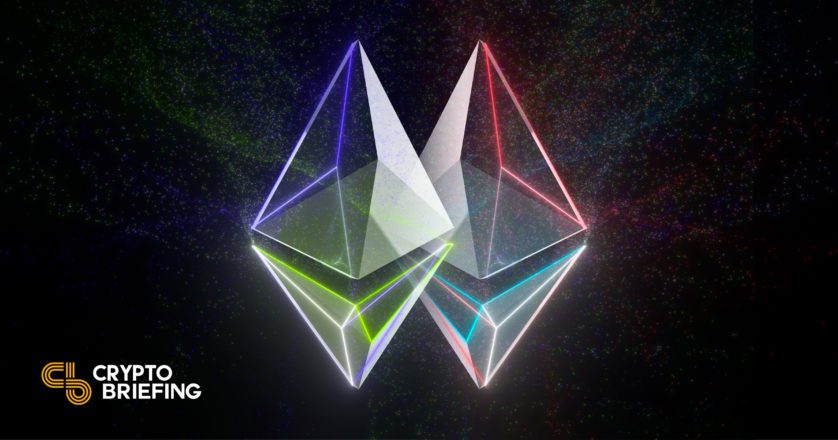What Could Go Wrong During Ethereum's Merge?
Ethereum’s transition to Proof-of-Stake may cause technical difficulties for centralized exchanges, dApps, and ETH holders trying to play a potential fork; however, most experts expect a generally smooth transition.

Key Takeaways
- Ethereum is upgrading to Proof-of-Stake in the next few hours.
- Centralized exchanges, Ethereum dApps, and potential Ethereum Proof-of-Work forks may end up causing trouble for ETH holders.
- While the Merge may turn out to be volatile, it is expected to be beneficial for Ethereum in the long run.
Share this article
Centralized exchanges, dApps, and Ethereum Proof-of-Work forks could face hiccups during Ethereum’s highly anticipated Merge to Proof-of-Stake.
The Merge Is Upon Us
Ethereum is gearing up to finally transition from Proof-of-Work to Proof-of-Stake. The highly anticipated transition, known in the crypto community as the Merge, is currently expected sometime between 04:45 and 05:36 UTC on September 15. The upgrade is expected to reduce ETH token issuance by 90% and slash the blockchain’s energy consumption by 99.5%.
At the time of writing, Ethereum sported a $192 billion market capitalization and more than $32 billion worth of collateral locked in its decentralized finance (DeFi) protocols. This makes the Merge a particularly high-stakes upgrade. While consensus in the crypto community is that Ethereum has a high chance of switching to Proof-of-Stake smoothly, it’s worth considering issues that may arise.
Centralized Exchange Downtime
Centralized crypto exchanges, even major ones, routinely go down during highly volatile events. In fact, just this week, Coinbase and FTX experienced significant outages when the crypto market severely dropped after the new CPI print of 8.3%. Should the Merge prove a volatile event, it would not be surprising for exchanges to undergo technical difficulties.
That being said, Coinbase, Binance, and FTX have all already indicated they would prepare for the Merge by pausing ETH and ERC-20 tokens transfers during the upgrade. These exchanges are, therefore, unlikely to find themselves blindsided by the event; they also all assured in press releases that trading services would be unaffected.
dApp Malfunctions
According to DappRadar, Ethereum hosts over 3,460 decentralized applications (dApps) on its blockchain. These include decentralized exchanges, NFT marketplaces, lending protocols, social media platforms, and games. Because the Merge will cause core elements of Ethereum’s structure to change, dApp developers need to adjust their code; those who don’t may find their applications suffering interruptions. DeFi protocols may be especially sensitive, as the algorithms managing liquidity pools, stablecoin backing, and automated market makers will likely need to be updated. Price volatility following the upgrade could cause further strain.
Major DeFi protocols appear to have prepared for the event, however. Lending platform Aave recently paused ETH loans to mitigate Merge-related liquidity risks. At the same time, top decentralized exchange Uniswap indicated that it was “eagerly awaiting” the Merge and that services would keep running smoothly.
Proof-of-Work Forks
Ethereum will no longer need miners after it switches away from Proof-of-Work, as the security of the blockchain will be assured by validators instead. While some Ethereum miners have started migrating away to other compatible Proof-of-Work blockchains (such as Ethereum Classic) others have declared their intent to fork Ethereum to keep a miner-friendly version of it running. This would in effect cause Ethereum to be split along two chains, one of them with a Proof-of-Stake consensus mechanism, the other with a Proof-of-Work one.
In such a scenario, ETH holders would be awarded new Ethereum Proof-of-Work (ETHW) tokens at a ratio of 1:1. While this is good news for market participants, the airdrop could come with difficulties. Depending on how competently the Ethereum fork is implemented, users may suffer from replay attacks, meaning that a transaction broadcasted on one blockchain could be mirrored on the other. For example, a user could accidentally end up selling 10 ETH when they were only trying to sell 10 ETHW. ETH holders should therefore act cautiously with their funds in the Merge’s immediate aftermath.
Final Thoughts
Ultimately, it’s worth remembering that no matter how volatile the Merge turns out, the upgrade is almost certainly a net positive for Ethereum in the long run. Nothing is required of ETH holders or NFT collectors during the event itself: for most users, the transition to Proof-of-Stake will most likely be perfectly seamless.
Disclaimer: At the time of writing, the author of this piece owned BTC, ETH, and several other cryptocurrencies.
